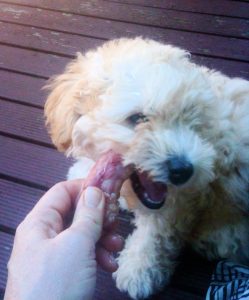Real food rules!
If it isn’t clear from other articles on my site, I’m a huge fan of feeding wholesome, fit-for-species food – for me and my dogs! In most cases (although not all) I believe that raw human grade foods offer the best foundation of health for our pets. But there is so much conflicting information out there about it, how do you decide if it is right for your pet? Here’s a little insight into the pros and cons based on my many years of researching the topic…..
What is a species appropriate diet for dogs?

While there are a few different models of raw feeding (prey model, frankin-prey, and biologically appropriate raw food – BARF), each with their benefits and drawbacks, I’ve favoured BARF as the model that offers a good balance of nutritional benefits.
A typical well prepared “BARF” diet has essential amino acids, protein, essential fatty acids, antioxidants, enzymes, most of the B group vitamins, and vitamins A and E. If you include raw bone and cartilage, you’re giving your dog a rich source of calcium phosphate, collagen and trace minerals. So what’s not to love?!
Raw foods also tend to be more digestible and ‘bio-available’, which means the animal’s digestive system can more readily assimilate the package of nutrients they contain. Cooking or processing raw meat can remove up to 70% of these valuable nutrients and also destroys vital enzymes and good bacteria for the gut, which are important for a range of biochemical processes in the body. Recent peer reviewed research ( has found that a dog’s gut biome is much healthier when feed real unadulterated meat compared with dry kibble.
Other benefits of raw based diet:
Raw diets offer a range of other health benefits for dogs including:

- Upper body and intestinal exercise from chewing on bones
- Help keep teeth clean and promote circulation in jaws and gums
- Mental health – dog’s get great pleasure from chewing on bones
- Helps promote good gut health, as it is a more stable source of enzymes and probiotics – the ‘good’ bacteria – to support immune system function
- Firmer, usually far less smelly stools to assist with expression of anal glands
- Increased hydration, as raw meat contains plenty of water (your dog will probably drink less water on raw)
- No artificial additives, which can reduce likelihood of allergies
Managing the risks
Of course, a raw meaty bone based diet is not without its risks, and it is important to be aware of them to determine whether the great benefits above outweigh the potential hazards. One of the most significant risks is that you are preparing a raw meal that isn’t balanced with the nutrients your dog needs to grow and thrive, particularly for puppies. You can overcome this one by looking for recipes that have been formulated to meet at least the minimal standards (see my various blogs on Making your own dog food and associated recipes) or fortunately now there are more dog food producers making balanced ready made raw mixes for your dog.
Here’s a few of the other more common risks people have asked me about in the past and ways you can help manage them to reduce their likelihood.
Is raw for all dogs?
So is raw ideal for all dogs? Not necessarily. While dogs share many similar needs, they are also individuals. Some dogs digestive systems just aren’t aren’t up to processing raw meats, at least initially. Dogs with a compromised GI tract should be introduced to raw foods much more slowly, particularly if they have spent many years primarily eating a starchy kibble.
For dogs in these circumstances, you might find it better to start transitioning to a good quality canned food, then move onto a balanced home made cooked diet (never cook bones though!) and introduce a little raw at a time.
If you are not quite ready for the idea of raw yourself, use a balanced recipe and lightly steam the meat components (not the bone). Always add any vegetable or other supplements after this light cooking. Your next option from a nutritional perspective would be freeze dried or dehydrated foods, then good quality canned. Kibble is a last resort in my doggie wellness world!
Any diet that you feed your dog (or yourself for that matter) will have its pros and cons. Being aware of what they are and how you can make the most of the benefits while managing the risks is a good step to making an informed choice in the interest of your beloved four legged pal.
Some sources of information that helped shape my views on this topic:
Bailey, S (2008), The Naturally Healthy Dog; Real Dogs Don’t Eat Kibble, Creative Genius, USA.
(2017) Key bacterial families (Clostridiaceae, Erysipelotrichaceae and Bacteroidaceae) are related to the digestion of protein and energy in dogs. PeerJ 5:e3019 https://doi.org/10.7717/peerj.3019
Billinghurst, Dr I (1993) Give Your Dog A Bone, 10th Print, Billinghurst Australia.
Brown, A (2006), The Whole Pet Diet, Celestial Arts, USA.
Flaim, D (2003), The Holistic Dog Book, Wiley Publishing, USA.
Lazarus, P (1999), Keep Your Dog Healthy the Natural Way, Ballantine Publishing Group, Canada.
Levy, J (1992), The Complete Herbal Handbook for the Dog and Cat, Faber and Faber, UK.
MacDonald, C (2004), Raw Dog Food: Make it Easy For You and Your Dog, Dogwise, USA.
Middle, Dr C (2008), Real Food for Dogs & Cats, Fremantle Press, Australia.
Mindell, Dr E & Renaghan, E (2007), Dr Earl Mindell’s Nutrition and Health for Dogs, Basic Health Publications, USA.
Olsen, L (2010), Raw & Natural Nutrition for Dogs, North Atlantic Books, USA.
Pitcairn, Dr R & Pitcairn, S (2005), Complete Guide to Natural Health for Dogs & Cats, Rodale, USA.
Schultze 1998, K (1998), Natural Nutrition for Dogs and Cats – The Ultimate Diet, Hay House, USA.
Taylor, B & Becker, K (2009), Dr Becker’s Real Food for Healthy Dogs & Cats, Natural Pet Productions, USA.


